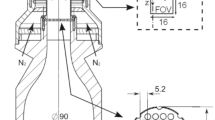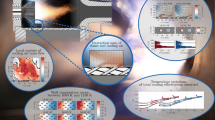Abstract
Flame–turbulence interactions are at the heart of modern combustion research as they have a major influence on efficiency, stability of operation and pollutant emissions. The problem remains a formidable challenge, and predictive modelling and the implementation of active control measures both rely on further fundamental measurements. Model burners with simple geometry offer an opportunity for the isolation and detailed study of phenomena that take place in real-world combustors, in an environment conducive to the application of advanced laser diagnostic tools. Lean premixed combustion conditions are currently of greatest interest since these are able to provide low NO x and improved increased fuel economy, which in turn leads to lower CO2 emissions. This paper presents an experimental investigation of the response of a bluff-body-stabilised flame to periodic inlet fluctuations under lean premixed turbulent conditions. Inlet velocity fluctuations were imposed acoustically using loudspeakers. Spatially resolved heat release rate imaging measurements, using simultaneous planar laser-induced fluorescence (PLIF) of OH and CH2O, have been performed to explore the periodic heat release rate response to various acoustic forcing amplitudes and frequencies. For the first time we use this method to evaluate flame transfer functions and we compare these results with chemiluminescence measurements. Qualitative thermometry based on two-line OH PLIF was also used to compare the periodic temperature distribution around the flame with the periodic fluctuation of local heat release rate during acoustic forcing cycles.











Similar content being viewed by others
References
Abu-Orf GM (1996), Laminar Flamelet Reaction Rate Modelling for Spark Ignition Engines. PhD thesis, University of Manchester Institute of Science and Technology
Ayoola B (2006) Laser-based measurement of heat release rate and temperature in turbulent premixed flames. PhD thesis, Department of Chemical Engineering, University of Cambridge, Cambridge
Ayoola BO, Balachandran R, Frank JH, Mastorakos E, Kaminski CF (2006) Spatially resolved heat release rate measurements in turbulent premixed flames. Combust Flame 144(1–2):1–16
Armitage CA, Riley AJ, Cant RS, Dowling AP, Stow SR (2004) Flame transfer functions from experiments and CFD. In: ASME TURBO EXPO, 2004-GT-53820
Armitage CA, Balachandran R, Mastorakos E, Cant RS (2006) Investigation of the nonlinear response of turbulent premixed flames to imposed inlet velocity oscillations. Combust Flame 146:419–436
Balachandran R, Ayoola BO, Kaminski CF, Dowling AP, Mastorakos E (2005) Experimental investigation of the nonlinear response of turbulent premixed flames to imposed inlet velocity oscillations. Combust Flame 143(1–2):37–55
Bellows BD, Lieuwen T (2004) Nonlinear response of combustor to forced acoustic oscillations. In: 42nd Aerospace science meeting and exhibit (Reno, NV, USA)
Bray KNC, Libby PA, Moss JB (1985) Unified modelling approach for premixed turbulent combustion. 1. General formulation. Combust Flame 61:87–102
Brookes SJ, Cant RS, Dowling AP (1999) In: ASME TURBO EXPO, 99-GT-112
Brookes SJ, Cant RS, Dowling AP, Dupére IIDJ (2000) In: ASME TURBO EXPO, 2000-GT-0104
Cattolica RJ, Vosen SR (1986) Two-dimensional fluorescence imaging of a flame–vortex interaction. Combust Sci Technol 48(1-2):77–87
Crosley DR (1981) Collisional effects on laser-induced fluorescence flame measurements. Opt Eng 27:511–521
Daly BJ, Harlow FH (1970) Transport equations in turbulence. Phys Fluids 13:2634
Dowling AP, Stow SR (2003) Acoustic analysis of gas turbine combustors. J Propuls Power 19(5):751–764
Dowling AP, Morgans AS (2005) Feedback controll of combustion oscillations. Ann Rev Fluid Mech 37:115–182
Eckbreth AC (1996) Laser diagnostics for combustion temperature and species. Abacus Press, Kent
Echekki T, Chen JH (1996) Unsteady strain rate and curvature effects in turbulent premixed methane–air flames. Combust Flame 116:184–202
Fayouxa A, Zähringer K, Gicquela O, Rolona JC (2005) Experimental and numerical determination of heat release in counterflow premixed laminar flames. Proc Combust Inst 30:251–257
Gaskell PH, Lau AK (1988) Comparison of 2 solution strategies for use with higher-order discretization schemes in fluid flow simulations. Int J Num Meth Fluids 8:617–641
Garland NL, Crosley DR (1986) On the collisional quenching of electronically excited OH, NH, and CH in flames. In: 21st Symposium (international) on combustion. The Combustion Institute, Pittsburg, pp 1693–1702
Giezendanner-Thoben R, Meier U, Meier W, Aigner M (2005a) Phase-locked temperature measurements by two-line OH-PLIF thermometry of a self-excited combustion instability in a gas turbine model combustor. Flow Turbul Combust 75(1–4):317–333
Giezendanner-Thoben R, Meier U, Meier W, Heinze J, Aigner M (2005b) Phase-locked two-line OH planar laser-induced fluorescence thermometry in a pulsating gas turbine model combustor at atmospheric pressure. Appl Opt 44(31):6565–6577
Hartung G (2008) Laser diagnostic investigations of flame turbulence interactions under lean-premixed conditions. PhD thesis, Department of Chemical Engineering, University of Cambridge, Cambridge
Hartung G, Hult J, Kaminski CF, Rogerson J, Swaminathan N (2008) Effect of heat release on turbulence and its interaction with scalar in premixed combustion. Phys Fluids 20:035,110
Issa R (1986) Solution of the implicitely discretized fluid-flow equations by operator-splitting. J Comp Phys 62:40–65
Jambunathan K, Ju XY, Dobbins BN, Ashforthfrost S (1995) An improved cross-correlation technique for particle image velocimetry. Meas Sci Technol 6(5):507–514
Kee RJ, Grcar JF, Smooke MD, Miller JA (1993) A FORTRAN program for modelling steady laminar one-dimensional premixed flames. Sandia National Laboratories Report SAND85-8240
Launder BE, Reece GJ, Rodi W (1975) Progress in development od a Reynolds-stress turbulence closure. J Fluid Mech 68:537–566
Lawn CJ, PoLIFke W (2004) A model for the thermoacoustic response of a premixed swirl burner, Part 2: the flame response. Combust Sci Technol 176(8):1359–1390
Lawn CJ, Evesque S, PoLIFke W (2004) A model for the thermoacoustic response of a premixed swirl burner, Part 1: acoustic aspects. Combustion Science and Technology 176(8):1331–1358
Lee JG, Santavicca D (2003) Experimental diagnostics for the study of combustion instabilities in lean premixed combustors. J Propuls Power 19(5):735–750
Lee T, North GL, Santavicca DA (1993) Surface properties of turbulent premixed propane/air flames at various Lewis numbers. Combust Flame 93:445–456
Li S-P, Cant RS (1994) In: Fourth Biennial UMIST CFD Colloquium
Najm HN, Paul P, Mueller C, Wyckoff PS (1998) On the adequacy of certain experimental observables as measurements of flame burning rate. Combust Flame 113(3):312–332
Palmer JL, Hanson RK (1996) Temperature imaging in a supersonic free jet of combustion gases with two-line OH fluorescence. Appl Opt 35(3):485–499
Paul PH, Najm HN (1998) Planar laser-induced fluorescence imaging of flame heat release rate. In: 27th International combustion symposium. Proc Combust Inst 27:43–50
Pun W, Palm SL, Culick FEC (2003) Combustion dynamics of an acoustically forced flame. Combust Sci Technol 175(3):499–521
Samaniego JM, Egolfopoulos FN, Bowman CT (1995) CO2* chemiluminescence in premixed flames. Combust Sci Technol 109(1–6):183–203
Tsujishita M, Hirano A, Yokoo M, Sakuraya T, Takeshita Y (1999) Accurate thermometry using NO and OH laser-induced fluorescence in an atmospheric pressure flame (checked by narrow-band N-2 coherent anti-stokes Raman scattering). JSME Int J Ser B Fluids Therm Eng 42(1):119–126
Vagelopoulos CM, Frank JH (2005) An experimental and numerical study on the adequacy of CH as a flame marker in premixed methane flames. Proc Combust Inst 30:241–249
Watkins AP, Li S-P, Cant RS (1996) In: Society of automotive engineers, SAE 961190
Acknowledgments
This work was supported by grants from the EPSRC and grants from Rolls-Royce within INTELLECT D.M. (Integrated lean low emission Combustor design methodology; FP6-502961). BA was supported by a case studentship from Rolls-Royce. GH is grateful to a case studentship from CMI (Cambridge-MIT Institute). JH was supported by an Advanced Research Fellowship from the EPSRC. CFK is thankful to the EPSRC for the provision of a PLATFORM grant and to the Leverhulme trust for personal sponsorship. RSC and CAA acknowledge the financial support of Rolls–Royce and DTI under the ATAP-10 programme. We gratefully acknowledge Dr. J. Frank for many inspiring discussions.
Author information
Authors and Affiliations
Corresponding author
Rights and permissions
About this article
Cite this article
Ayoola, B., Hartung, G., Armitage, C.A. et al. Temperature response of turbulent premixed flames to inlet velocity oscillations. Exp Fluids 46, 27–41 (2009). https://doi.org/10.1007/s00348-008-0534-0
Received:
Revised:
Accepted:
Published:
Issue Date:
DOI: https://doi.org/10.1007/s00348-008-0534-0




